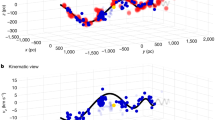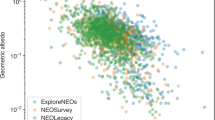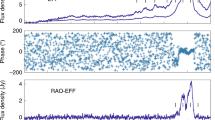Abstract
ASTEROID collisions are an important source of the dust particles in the zodiacal cloud1–3. These particles spiral in towards the Sun under the influence of drag forces4–6 and, in passing through the inner Solar System, are subject to gravitational perturbations by the planets, which may trap them (at least temporarily) in orbital resonances7–10. Recently, numerical simulations have shown that resonances with the Earth are particularly effective at trapping asteroidal dust, leading to the suggestion that the Earth may be embedded in a circumsolar ring of dust11. The azimuthal structure of this ring was predicted to be asymmetric, with the region trailing the Earth being substantially more dense than that in the leading direction11. This prediction is in both qualitative and quantitative agreement with the asymmetry in zodiacal light observed by the Infrared Astronomical Satellite (IRAS)11,12, but the IRAS data alone are equivocal because of calibration uncertainties and sparse coverage of elongation angle12. Here we report observations by the Diffuse Infrared Background Experiment13 (DIRBE) on the Cosmic Background Explorer satellite (COBE)14, which confirm both the existence of this ring and the predictions of its near-Earth structure.
This is a preview of subscription content, access via your institution
Access options
Subscribe to this journal
Receive 51 print issues and online access
$199.00 per year
only $3.90 per issue
Buy this article
- Purchase on Springer Link
- Instant access to full article PDF
Prices may be subject to local taxes which are calculated during checkout
Similar content being viewed by others
References
Low, F. J. et al. Astrophys. J. 278, L19–L22 (1984).
Dermott, S. F., Nicholson, P. D., Burns, J. A. & Houck, J. R. Nature 312, 505–509 (1984).
Sykes, M. V. Icarus 84, 267–289 (1990).
Wyatt, S. P. & Whipple, F. L. Astrophys. J. 111, 134–141 (1950).
Burns, J. A., Lamy, P. L. & Soter, S. Icarus 40, 1–48 (1979).
Reach, W. T. Astrophys. J. 392, 289–299 (1992).
Jackson, A. A. & Zook, H. A. Nature 337, 629–631 (1989).
Jackson, A. A. & Zook, H. A. Icarus 97, 70–84 (1992).
Sicardy, B., Beaugé, C., Ferraz-Mello, S., Lazzaro, D. & Roques, F. Celestial Mech. dynamical Astr. 57, 373–390 (1993).
Weidenschilling, S. J. & Jackson, A. A. Icarus 104, 244–254 (1993).
Dermott, S. F., Jayraraman, S., Xu, Y. L., Gustafson, B. Å. S. & Liou, J. C. Nature 369, 719–723 (1994).
Reach, W. T. Astrophys. J. 369, 529–543 (1991).
Hauser, M. G. in Back to the Galaxy (eds Holt, S. & Verter, F.) 201–205 (Am. Inst Phys, New York, 1993).
Boggess, N. W. et al. Astrophys. J. 397, 420–429 (1992).
Reach, W. T. Astrophys. J. 335, 468–485 (1988).
Spiesman, W. J. et al. Astrophys. (in the press).
Leinert, C. Space Sci. Rev. 18, 281–339 (1975).
Giese, R. H., Kneissel, B. & Rittich, U. Icarus 68, 395–411 (1986).
Good, J. C., Gautier, T. N. & Hauser, M. G. Adv. Space Res. 6, 84–86 (1986).
Hong, S. S. Astr. Astrophys. 148, 67–75 (1985).
Grün, E., Zook, H. A., Fechtig, H. & Giese, R. H. Icarus 62, 244–272 (1985).
Author information
Authors and Affiliations
Rights and permissions
About this article
Cite this article
Reach, W., Franz, B., Weiland, J. et al. Observational confirmation of a circumsolar dust ring by the COBE satellite. Nature 374, 521–523 (1995). https://doi.org/10.1038/374521a0
Received:
Accepted:
Issue Date:
DOI: https://doi.org/10.1038/374521a0
This article is cited by
-
Parker Solar Probe: Four Years of Discoveries at Solar Cycle Minimum
Space Science Reviews (2023)
-
Collisional evolution and the resulting mass distribution of interplanetary dust
Earth, Planets and Space (2014)
-
On the stability of dust orbits in mean-motion resonances perturbed by from an interstellar wind
Celestial Mechanics and Dynamical Astronomy (2014)
-
Orbital Perturbations Due to Massive Rings
Earth, Moon, and Planets (2012)
-
Influence of fast interstellar gas flow on the dynamics of dust grains
Celestial Mechanics and Dynamical Astronomy (2012)
Comments
By submitting a comment you agree to abide by our Terms and Community Guidelines. If you find something abusive or that does not comply with our terms or guidelines please flag it as inappropriate.



